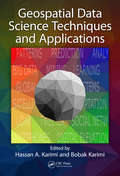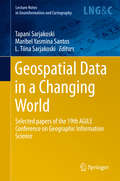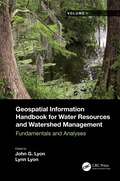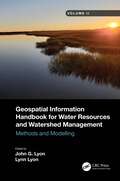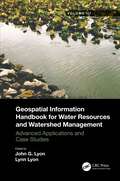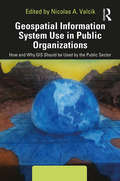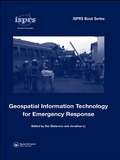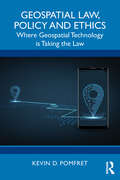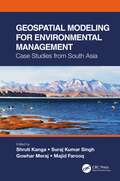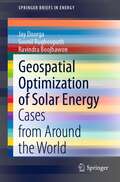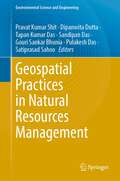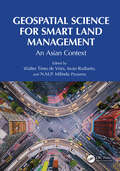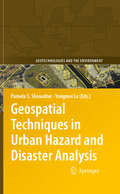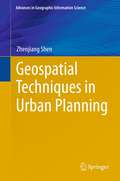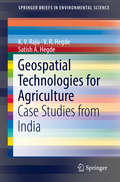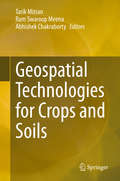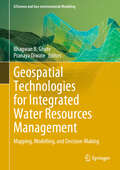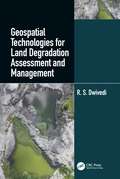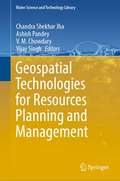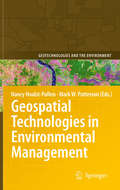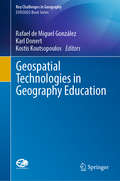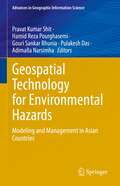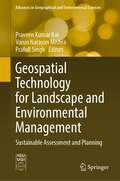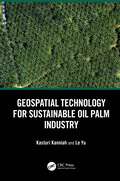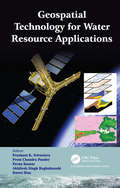- Table View
- List View
Geospatial Data Science Techniques and Applications
by Hassan A. Karimi and Bobak KarimiData science has recently gained much attention for a number of reasons, and among them is Big Data. Scientists (from almost all disciplines including physics, chemistry, biology, sociology, among others) and engineers (from all fields including civil, environmental, chemical, mechanical, among others) are faced with challenges posed by data volume, variety, and velocity, or Big Data. This book is designed to highlight the unique characteristics of geospatial data, demonstrate the need to different approaches and techniques for obtaining new knowledge from raw geospatial data, and present select state-of-the-art geospatial data science techniques and how they are applied to various geoscience problems.
Geospatial Data in a Changing World
by Maribel Yasmina Santos Tapani Sarjakoski L. Tiina SarjakoskiThis book collects innovative research presented at the 19th Conference of the Association of Geographic Information Laboratories for Europe (AGILE) on Geographic Information Science, held in Helsinki, Finland in 2016.
Geospatial Information Handbook for Water Resources and Watershed Management, Volume I: Fundamentals and Analyses
by Lyon John G.Volume I of Geospatial Information Handbook for Water Resources and Watershed Management discusses fundamental characteristics, measurements, and analyses of water features and watersheds including lakes and reservoirs, rivers and streams, and coasts and estuaries. It presents contemporary knowledge on Geospatial Technology (GT)–supported functional analyses of water runoff, storage and balance, flooding and floodplains, water quality, soils and moisture, climate vulnerabilities, and ecosystem services. Captures advanced Geospatial Technologies (GTs) addressing a wide range of water issues Provides real-world applications and case studies using advanced spectral and spatial sensors combined with geospatially facilitated water process models Details applications of ArcInfo/ArcGIS, Google Earth Engine, and other systems using advanced remote sensors, including hyperspectral ER2 AVIRIS, Sentinel-1 and -2, MODIS, Landsat 7 ETM+, Landsat 8 OLI and TIPS, SAR radar, and thermal imaging Global in coverage with applications contributed by more than 170 authors with lifelong expertise in water sciences and engineering This handbook is a wide-ranging and contemporary reference of advanced geospatial techniques used in numerous practical applications at the local and regional scales and is an in-depth resource for professionals and the water research community worldwide.
Geospatial Information Handbook for Water Resources and Watershed Management, Volume II: Methods and Modelling
by G. Lyon JohnVolume II of Geospatial Information Handbook for Water Resources and Watershed Management discusses Geospatial Technology (GT) approaches using integrated modeling as applied to advanced water resource assessments. Features include multiple date land cover analyses as change in land cover influences water quality, model sensitivity analyses of DEM resolution and influences on modeling water characteristics like Manning’s n, development of seabed cover classification and sensitivity, and forecasting urban growth over time with climate vulnerability impacts on water. A detailed case study presents a range of water quality issues, all effectively demonstrating GT inputs to water quality studies from headwaters to receiving estuarine waters. Also analyzed are the comparison of evapotranspiration simulation performance by APEX model in dryland and irrigated cropping systems and perspectives on the future of transient storage modeling. Captures advanced technologies and applications for implementation with models to address a broad spectrum of water issues Provides real-world applications and case studies using advanced spectral and spatial sensors combined with geospatially facilitated water process models Features a Neuse River Basin case study integrating hydrologic methods and modeling along with remote sensing and GIS technologies for nonpoint source water quality evaluations Global coverage with applications demonstrated by more than 170 experts from around the world This handbook is a wide-ranging and contemporary reference of advanced geospatial techniques used in numerous practical applications at the local and regional scale and is an in-depth resource for professionals and the water research community worldwide.
Geospatial Information Handbook for Water Resources and Watershed Management, Volume III: Advanced Applications and Case Studies
by G. Lyon JohnVolume III of Geospatial Information Handbook for Water Resources and Watershed Management discusses water and watershed issues such as water quality, evapotranspiration, water resource management, and ecological services. Featured is a two-stage ditch and river geomorphology case study section with related water geospatial applications, including historical image analyses of floodplains and channels and resulting change in river geomorphology through erosion and transport and influence on dependent vegetation communities. Captures advanced Geospatial Technologies (GT) and their applications to address a wide spectrum of water issues Provides real-world two-stage ditch and river geomorphology case studies using river, stream and channel measures and change models, and bankfull discharge modeling Global in coverage with applications demonstrated by more than 170 experts in water sciences and two-stage ditch and river geomorphology This handbook is a wide-ranging and contemporary reference of advanced geospatial techniques used in numerous practical applications at the local and regional scale and is an in-depth resource for professionals and the water research community worldwide.
Geospatial Information System Use in Public Organizations
by Nicolas Valcik Denis DeanThis book shows how Global Information Systems (GIS) can be used for operations management in public institutions. It covers theory and practical applications, ranging from tracking public health trends to mapping transportation routes, to charting the safest handling of hazardous materials. Along with an expert line-up of contributors and case studies, the editors provide a complete overview of how to use GIS as part of a successful, collaborative data analysis, and how to translate the information into cost-saving decisions, or even life-saving ones.
Geospatial Information Technology for Emergency Response
by Sisi Zlatanova Jonathan LiDisaster management is generally understood to consist of four phases: mitigation, preparedness, response and recovery. While these phases are all important and interrelated, response and recovery are often considered to be the most critical in terms of saving lives. Response is the acute phase occurring after the event, and includes all arrangemen
Geospatial Law, Policy and Ethics: Where Geospatial Technology is Taking the Law
by Kevin D. PomfretThis comprehensive textbook identifies the emerging legal, policy, and ethical considerations associated with the collection, analysis, storage, and distribution of data that can be tied to location on Earth – otherwise known as “geospatial information.”Drawing on the author’s extensive professional, legal, and scholarly experience in the geospatial community, the book explains how these issues cut across both legal and technology domains and how they impact geospatial information management across the globe. While focused on the USA, the framework and analysis can be applied to other nations and legal systems. Key topics covered include intellectual property, privacy, data protection, data quality and liability, security, ethical issues, licensing, and the impact of existing and emerging technologies, such as artificial intelligence, satellites, drones, software, machine learning, small satellites, and 5G. The book includes helpful features, such as a glossary of key legal terms and further reading, and is accompanied by digital supplements in the form of PowerPoint slides for each chapter.Geospatial Law, Policy and Ethics is the ideal companion for advanced undergraduate and graduate-level students of Geographic Information System (GIS), remote sensing geospatial intelligence, geospatial studies, and spatial data science courses. It will also be of interest to geospatial professionals employed in industry, government, or research.
Geospatial Modeling for Environmental Management: Case Studies from South Asia
by Shruti KangaThis is a comprehensive resource that integrates the application of innovative remote sensing techniques and geospatial tools in modeling Earth systems for environmental management beyond customary digitization and mapping practices. It identifies the most suitable approaches for a specific environmental problem, emphasizes the importance of physically based modeling, their uncertainty analysis, advantages, and disadvantages. The case studies on the Himalayas with a complex topography call for innovation in geospatial techniques to find solutions for various environmental problems. Features: Presents innovative geospatial methods in environmental modeling of Earth systems. Includes case studies from South Asia and discusses different processes and outcomes using spatially explicit models. Explains contemporary environmental problems through the analysis of various information layers. Provides good practices for developing countries to help manage environmental issues using low-cost geospatial approaches. Integrates geospatial modeling with policy and analysis its direct implication in decision making. Using a systems’ approach analysis, Geospatial Modeling for Environmental Management: Case Studies from South Asia shall serve environmental managers, students, researchers, and policymakers.
Geospatial Optimization of Solar Energy: Cases from Around the World (SpringerBriefs in Energy)
by Jay Doorga Soonil Rughooputh Ravindra BoojhawonThis book provides a comprehensive guide on how geographic information systems (GIS) can be used to optimize solar energy resources. A collection of the latest cutting-edge research is presented which seeks to address the most pressing issues faced by policymakers regarding the planning and exploitation of solar energy. Scientifically robust models are developed to guide researchers on identifying optimum sites for the implementation of solar energy projects. Each methodology presented is accompanied by global case studies, ranging from the small islands of Hawaii and Mauritius to larger countries such as India and Spain. This book is primarily targeted to researchers aspiring to unveil and optimize the solar resource potential of their countries for the benefit of a wider audience, ranging from architects, agro-industrialists, climatologists, and energy experts.
Geospatial Practices in Natural Resources Management (Environmental Science and Engineering)
by Tapan Kumar Das Gouri Sankar Bhunia Pravat Kumar Shit Pulakesh Das Dipanwita Dutta Sandipan Das Satiprasad SahooThis book provides a multidisciplinary synthesis of the sustainable management of natural resources. The book presents applicable knowledge of land, water, and forest resources along with in-depth investigations of multiple management pathways. This book also demonstrated the contemporary applications of geospatial technology in data mining techniques, data analysis, modeling, assessment, and visualization, and appropriate management strategies in different aspects of natural resources. The book explores the latest state-of-the-art techniques using open-source software, statistical programming, and modeling platforms, including artificial intelligence techniques in natural resource management. It is a valuable resource for students, researchers, and practitioners in geography, geospatial sciences, and environmental sciences, especially those interested in land, water, and forest resources.
Geospatial Science for Smart Land Management: An Asian Context
by Walter Timo de Vries Iwan Rudiarto N.M.P. Milinda PiyasenaResponsible land distribution in Asia, with ever-increasing limitations in space, requires the use of smart technologies, sophisticated models, intelligent algorithms, and big data repositories. This book presents new land management perspectives and fit-for-purpose, flexible, dynamic, and effective solutions for land management and land administration problems. Written by global experts from different Asian countries, including China, India, Indonesia, Iran, Japan, South Korea, Thailand, Vietnam, etc., all these cases demonstrate how and why the uptake of geospatial technologies is booming and how to handle land scarcity and competing spatial interests in both urban and rural areas in Asia. FEATURES Summarizes trends of geospatial technologies in Asia Describes and applies leading-edge geospatial models Explains fit-for-purpose digital land administration Provides case studies and examples that include the use of smart land management tools Helps readers advance their understanding of geospatial and land management science Truly an interdisciplinary book, this text is a practical guide for an array of readers, such as practitioners in public and private companies involved in both geospatial and land management applications, as well as graduate students, researchers, academics, and professionals working in land administration, land management, spatial planning, real estate studies, geosciences, geoinformatics, and geodesy.
Geospatial Techniques in Urban Hazard and Disaster Analysis
by Pamela S. Showalter Yongmei LuThis book examines how Geographic Information Technologies (GIT) are being implemented to improve our understanding of a variety of hazard and disaster situations. The volume is a compilation of recent research using Geographic Information Systems (GIS), Remote Sensing (RS) and other technologies such as Global Positioning Systems (GPS) to examine urban hazard and disaster issues. The goal is to improve and advance the use of such technologies during four classic phases of hazard and disaster research: response, recovery, preparation and mitigation. The focus is on urban areas, broadly defined in order to encompass rapidly growing and densely populated areas. The material presented is multidisciplinary, with contributions from scholars in Africa, Asia, Europe, Latin America and North America, and is presented in five key sections: sea level rise and flood analysis earthquakes and tsunamis and international applications hurricane response/recovery metropolitan case studies evacuation studies This volume contributes to our understanding of extreme events in urban environments with the use of GIT and expanding its role at the local, regional, state and federal levels. The book is a valuable reference for academic researchers and professionals and practitioners working in hazard management and mitigation.
Geospatial Techniques in Urban Planning
by Zhenjiang ShenThis work presents cases studies of applications of Geotechnology such as Geography Information Systems, virtual reality and cellular automaton and multi-agent systems in the field of urban planning and design.These are joint research presentations with students and colleagues from Kanazawa University. All these case studies are about application in Japanese or Chinese cities, which are on-field examples reflecting the enormous spread of geo-computation technology. Nevertheless, the concepts have wide applicability to other contexts. The works can be classified into three types of Geotechnological applications at different levels of urban spaces, which are relevant to different kinds of urban planning and development projects. The book is comprised of three parts: Part 1: Geosimulation and land use plan Part 2: Geo Visualization and urban design Part 3: Geography information system and planning support
Geospatial Technologies for Agriculture: Case Studies from India (SpringerBriefs in Environmental Science)
by K. V. Raju V. R. Hegde Satish A. HegdeThis book uniquely presents accurate and up-to-date information related to crops in small and fragmented agricultural lands with mixed cropping patterns. The book involves research using remote sensing (RS), Global Positioning Systems (GPS) and Geographic Information Systems (GIS) to develop crop inventories in three growing seasons in three villages across India to inform decision makers and planners on best practices for agricultural management. The data analysis of crop details using various geospatial technologies fills in gaps in statistical agriculture research, and provides reliable, replicable and efficient methods for generating agricultural statistics. The book will be of interest to statisticians, planners and decision makers in crop management and production.
Geospatial Technologies for Crops and Soils
by Ram Swaroop Meena Tarik Mitran Abhishek ChakrabortyThe sustainable development of the agriculture sector is the only option to meet the demands of increased and economically viable production in a changing climate. This means there is a need to introduce the latest technologies to enhance production, and also help policymakers make decisions for the future. Geospatial technologies & tools, such as remote sensing, geographical information systems (GIS), global positioning systems (GPS), and mobile & web applications, provide unique capabilities to analyze multi-scale, multi-temporal datasets, and support decision-making in sustainable agriculture development and natural resources management. Further, the availability of reliable and timely geospatial information on natural resources and environmental conditions is essential for sustainable agricultural development and food security. Since remote sensing solutions are fast, non-destructive and have large spatial coverage, they can play a significant role in the identification, inventory, and mapping of land resources. Over the past four decades, remote sensing has proved to be a cost-effective and powerful tool to assess crop and soil properties in varying spatial and temporal scales using both visual and digital techniques. Satellite remote sensing coupled with GIS & mobile-app based positional information has emerged as an efficient tool for optimizing input resources, and minimizing cost of production and risk of biotic/ abiotic factors nature to promote sustainable agriculture. This book comprehensively documents the applications of space-based technologies for crop and soil assessments for the sustainable development of agriculture.
Geospatial Technologies for Integrated Water Resources Management: Mapping, Modelling, and Decision-Making (GIScience and Geo-environmental Modelling)
by Bhagwan B. Ghute Pranaya DiwateThis book examines water resources, helps understand complexities in water management, and explains the use of geospatial technology. By 2050, the world will have nearly about 9.8 billion population and which is almost 2.5 to 3 billion added to the present population. Only 3% of world water resources are available for human consumption. Even some resources are polluted because of poor management. Water management is important since it helps determine future irrigation prospects. Management of water resources under set policies and regulations. Water is a more valuable commodity and the world is facing acute water shortages because of drought which is attributed to climate change and overuse. Many rivers are drying up, polluted and encroached. Now the challenge is whether future generations will have enough fresh water for living. Geospatial Technology i.e. Remote Sensing (RS) and GIS have gained considerable interest among earth and hydrological science communities for solving and understanding various complex issues and approaches towards water resources development and management. Water can provide sustainability to any region. Sustainability means that meet the needs of the present, without compromising the ability of future generations to meet their own needs. These are generally integrated to study a variety of natural resources and their characteristics. Major advancements have been accomplished in integrating remote sensing and GIS and they complement each other. RS is used for acquiring information for GIS. Remote sensing and GIS integration provide information on the spatial variation, extent, and potential and limitations of natural resources, which is essential for planning the strategy for sustainable development. Most hydrological or geomorphological models are developed in a GIS framework and these are helpful for the planning and management of water and decision-makers for sustainable development.
Geospatial Technologies for Land Degradation Assessment and Management
by R. S. DwivediThe constant growth of the world’s population and the decline of the availability of land and soil resources are global concerns for food security. Other concerns are the decrease in productivity and delivery of essential ecosystems services because of the decline of soil quality and health by a range of degradation processes. Key soil properties like soil bulk density, organic carbon concentration, plant available water capacity, infiltration rate, air porosity at field moisture capacity, and nutrient reserves, are crucial properties for soil functionality which refers to the capacity of soil to perform numerous functions. These functions are difficult to measure directly and are estimated through indices of soil quality and soil health. Soil degradation, its extent and severity, can also be estimated by assessing indices of soil quality and health. "Geospatial Technology for Land Degradation Assessment and Management" uses satellite imagery and remote sensing technologies to measure landscape parameters and terrain attributes. Remote sensing and geospatial technologies are important tools in assessing the extent and the severity of land and soil degradation, their temporal changes, and geospatial distribution in a timely and cost-effective manner. The knowledge presented in the book by Dr. R.S. Dwivedi shows how remote sensing data can be utilized for inventorying, assessing, and monitoring affected ecosystems and how this information can be integrated in the models of different local settings. Through many land degradations studies, land managers, researchers, and policymakers will find practical applications of geospatial technologies and future challenges. The information presented is also relevant to advancing the Sustainable Development Goals of the United Nations towards global food security.
Geospatial Technologies for Resources Planning and Management (Water Science and Technology Library #115)
by Vijay Singh Ashish Pandey V. M. Chowdary Chandra Shekhar JhaThis book focuses on the application of geospatial technologies for resource planning and management for the key natural resources, e.g. water, agriculture and forest as well as the decision support system (DSS) for infrastructure development. We have seen in the past four decades that the growing complexities of sustainable management of natural resources management have been very challenging. The book has been written to leverage the current geospatial technologies that integrate the remotely sensed data available from various platforms, the precise locational data providing geospatial intelligence, and the advanced integration tools of Geographical Information Systems (GIS). Geospatial technologies have been used for water resources management employing geomorphological characteristics, analysis of river migration pattern, understanding the large-scale hydrological process, wet land classification and monitoring, analysis of glacial lake outburst flood (GLOF), assessment of environmental flow and soil erosion studies, water quality modelling and assessment and rejuvenation of paleochannels through groundwater recharge. Geospatial technologies have been applied for crop classification and mapping, soil moisture determination using RISAT-1 C-band and PALSAR-2 L-band sensors, inventory of horticulture plantations, management of citrus orchards, crop yield forecasting, rice yield estimation, estimation of evapotranspiration and its evaluation against lysimeter and satellite-based evapotranspiration product for India to address the various issues of the agricultural system management. Geospatial technologies have been used for generation of digital elevation model, urban dynamics assessment, mobile GIS application at grass root level planning, cadastral level developmental planning and e-governance applications, system dynamics for sustainable development, micro-level water resources planning, site suitability for sewage treatment plant, traffic density assessment, geographical indications of India, archaeological applications and disasters interventions to elaborate various issues of DSS for infrastructure development and management. Geospatial technologies have been employed for the generation and reconciliation of the notified forest land boundaries, and also the land cover changes analysis within notified forest areas, forest resource assessment, management and monitoring and wildlife conservation and management. This book aims to present high-quality technical case studies representing the recent developments in the “application of geospatial technologies for resource planning and management”. The editors hope that this book will serve as a valuable resource for scientists and researchers to plan and manage land and water resources sustainably.
Geospatial Technologies in Environmental Management
by Mark W. Patterson Nancy Hoalst-PullenThe book explores new approaches and applications of geospatial technologies to understand past, present and future impacts environmental policies and management practices have on the landscape. From forestry to water use, and from wildlife management to agricultural practices, this collection of case studies examines the application of geospatial technologies in managing natural resources, land use, and environmental systems. These case studies are current and written by leading international geospatial technology practitioners. They also incorporate the causative and resultant roles of environmental policies and management within a geospatial context. The book is scientific and research-oriented, yet appealing to a broad audience interested in environmental applications of geospatial technologies, thus making it an important reference source for the fields of GIS, remote sensing, geography, environmental policy and environmental science.
Geospatial Technologies in Geography Education (Key Challenges in Geography)
by Rafael de Miguel González Kostis Koutsopoulos Karl DonertThis book addresses new pedagogies focusing on the use of geospatial technologies and geomedia in the classroom. Today, geospatial technologies are substantially influencing geography teaching and learning, particularly in secondary education. Web-GIS, virtual globes, storytelling, maps and apps for mobile devices are transforming the nature and design of geography curricula, instructional processes, didactics, resources and assessments. Undoubtedly, geography is among those school subjects that have benefited most from the implementation of new technologies in the classroom. Geospatial technologies can be used to develop inquiry-based learning or project-based learning pedagogies and help students to acquire spatial reasoning and spatial citizenship skills in the context of education for sustainable development.This book highlights a range of initiatives, projects and educational practices – from several European countries and settings – related to geospatial challenges in geography education. Given its scope, it will be equally appealing to scientists, students and teachers of geography and other fields using geospatial technologies and geomedia.
Geospatial Technology for Environmental Hazards: Modeling and Management in Asian Countries (Advances in Geographic Information Science)
by Hamid Reza Pourghasemi Gouri Sankar Bhunia Pravat Kumar Shit Pulakesh Das Adimalla NarsimhaThe book demonstrates the geospatial technology approach to data mining techniques, data analysis, modeling, risk assessment, visualization, and management strategies in different aspects of natural and social hazards. This book has 25 chapters associated with risk assessment, mapping and management strategies of environmental hazards. It covers major topics such as Landslide Susceptibility, Arsenic Contaminated Groundwater, Earthquake Risk Management, Open Cast Mining, Soil loss, Flood Susceptibility, Forest Fire Risk, Malaria prevalence, Flood inundation, Socio-Economic Vulnerability, River Bank Erosion, and Socio-Economic Vulnerability. The content of this book will be of interest to researchers, professionals, and policymakers, whose work involves environmental hazards and related solutions.
Geospatial Technology for Landscape and Environmental Management: Sustainable Assessment and Planning (Advances in Geographical and Environmental Sciences)
by Praveen Kumar Rai Varun Narayan Mishra Prafull SinghGeospatial technology is a combination of state-of-the-art remote sensing and technology for geographic information systems (GIS) and global navigation satellite systems (GNSS) for the mapping and monitoring of landscapes and environment. The main thrust of using geospatial technology is to understand the causes, mechanisms, and consequences of spatial heterogeneity, while its ultimate objective is to provide a scientific basis for developing and maintaining ecologically, economically, and socially sustainable landscapes. This book presents new research on the interdisciplinary applications of geospatial technology for identification, assessment, monitoring, and modelling issues related to landscape, natural resources, and environmental management. The book specifically focuses on the creation, collection, storage, processing, modelling, interpretation, display, and dissemination of spatio-temporal data, which help to resolve environmental management issues including ecosystem change, resource utilization, land use management, and environmental pollution. The positive environmental impacts of information technology advancements with regard to global environmental and climate change are also discussed. The book addresses the interests of a wide spectrum of readers who have a common interest in geospatial science, geology, water resource management, database management, planning and policy making, and resource management.
Geospatial Technology for Sustainable Oil Palm Industry
by Kasturi Kanniah Le YuOil palm cultivation is known to be one of the leading causes of deforestation and degradation of the environment. This book introduces and explains the application of geospatial technology to an established and important tropical agricultural industry for responsible and sustainable management.
Geospatial Technology for Water Resource Applications (100 Key Points)
by Prashant K. Srivastava Pavan Kumar Prem Chandra Pandey Akhilesh Singh Raghubanshi Dawei HanThis book advances the scientific understanding, development, and application of geospatial technologies related to water resource management. It presents recent developments and applications specifically by utilizing new earth observation datasets such as TRMM/GPM, AMSR E/2, SMOS, SMAP and GCOM in combination with GIS, artificial intelligence, and hybrid techniques. By linking geospatial techniques with new satellite missions for earth and environmental science, the book promotes the synergistic and multidisciplinary activities of scientists and users working in the field of hydrological sciences.
